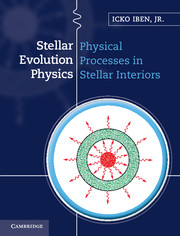Book contents
- Frontmatter
- Contents
- Preface
- Part I Introduction and overview
- Part II Basic physical processes in stellar interiors
- 3 Properties of and physical processes in main sequence stars–order of magnitude estimates
- 4 Statistical mechanics, thermodynamics, and equations of state
- 5 Polytropes and single zone models
- 6 Hydrogen-burning reactions and energy-generation rates
- 7 Photon–matter interaction probabilities, absorption cross sections, and opacity
- 8 Equations of stellar evolution and methods of solution
- Part III Pre-main sequence, main sequence, and shell hydrogen-burning evolution of single stars
- Index
- References
8 - Equations of stellar evolution and methods of solution
from Part II - Basic physical processes in stellar interiors
Published online by Cambridge University Press: 05 December 2012
- Frontmatter
- Contents
- Preface
- Part I Introduction and overview
- Part II Basic physical processes in stellar interiors
- 3 Properties of and physical processes in main sequence stars–order of magnitude estimates
- 4 Statistical mechanics, thermodynamics, and equations of state
- 5 Polytropes and single zone models
- 6 Hydrogen-burning reactions and energy-generation rates
- 7 Photon–matter interaction probabilities, absorption cross sections, and opacity
- 8 Equations of stellar evolution and methods of solution
- Part III Pre-main sequence, main sequence, and shell hydrogen-burning evolution of single stars
- Index
- References
Summary
The discipline of stellar structure asks: given the opacity and the energy-generation rate as functions of composition, density, and temperature, and given the composition as a function of mass, what is the model structure in the static approximation? The discipline of stellar evolution asks: how, due to a combination of nuclear transformations and mixing processes, does the distribution of composition variables in a model star change with time, and how does the structure respond to these changes and to the loss of energy in the form of photons from the surface and neutrinos from the interior by the conversion of gravitational potential energy into heat and work and by the conversion of heat and work into gravitational potential energy. For a wide variety of situations, it is possible to explore evolution in the quasistatic approximation, which follows when bulk acceleration in an equation relating pressure-gradient and gravitational forces is neglected and the contribution to the internal energy of the kinetic energy of bulk motions is neglected. Nevertheless, meaningful estimates of bulk velocities follow as a consequence of changes in gravothermal characteristics required by the conservation of energy.
In order to reveal the full character of the quasistatic approximation, structure equations are derived in Section 8.1 without assuming spherical symmetry or placing restrictions on the acceleration. By invoking the conservation of mass, linear momentum, and energy, it is shown how the work done by gravity is translated by pressure-gradient forces into a primary component of the local gravothermal energy-generation rate ϵgrav and how, in regions where particles are being created and destroyed, another component of ϵgrav depends on the rates of creation and destruction of particles. An important theorem is derived which shows that, although the local rate at which gravity does work differs from the local rate at which pressure-gradient forces do work, the global rate at which gravity does work is identical with the global rate at which pressure-gradient forces do work.
- Type
- Chapter
- Information
- Stellar Evolution Physics , pp. 435 - 526Publisher: Cambridge University PressPrint publication year: 2012



